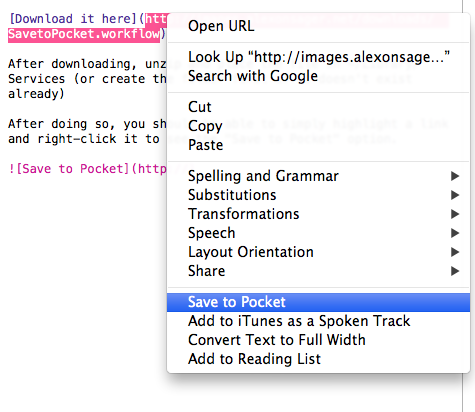Geoguessr
See a Google Street View at a random point in the world, guess where it is on a map.
Save to Pocket - OSX Service
Here’s a quick Mac OSX service that will allow you to save any link to Pocket by right-clicking it. It will work from within basically any app that lets you right-click text. Prerequisite is that you have the Pocket OSX app installed.
After downloading, unzip and place the file in ~/Library/Services (or create the folder first if it doesn’t exist already)
After doing so, you should be able to simply highlight a link and right-click it to see the “Save to Pocket” option. (You might find it under a “Services” category)

Guillaume Lorentz dances to Macklemore's 'Can't Hold Us'
I absolutely love the energy
'Gitmo is Killing Me'
A chilling story told by a prisoner at Guantanamo Bay. I hope that someday we’ll look back and wonder how anything like this could have been possible.
I’ve been detained at Guantánamo for 11 years and three months. I have never been charged with any crime. I have never received a trial.
[…]
The situation is desperate now. All of the detainees here are suffering deeply. At least 40 people here are on a hunger strike. People are fainting with exhaustion every day. I have vomited blood.
And there is no end in sight to our imprisonment. Denying ourselves food and risking death every day is the choice we have made.
I just hope that because of the pain we are suffering, the eyes of the world will once again look to Guantánamo before it is too late.
Computer program that learns to play classic NES games
The program is given a set of inputs from a human playing the game, and analyzes the RAM to define success in the game. It then plays the game with no knowledge of the rules, and works incredibly well.
North Korea missle launch delayed by Windows 8
#OnionOrActualHeadline
The announcement from the Korean Central News Agency (KCNA) did not indicate a new scheduled time for a missile test, saying only that it was “working with Windows 8 support to resolve the issue.”
A source close to the North Korean regime reported that Supreme Leader Kim Jong-un is furious about the Windows 8 problems and is considering a number of options, including declaring war on Microsoft.
Daft Punk Skrillex Remix - Conte
I’ve always been a fan of Jack’s solo work and his work as part of Pomplamoose. His new electronic sound is excellent as well.
Skycons - Free HTML5 weather icons
Skycons is a set of ten animated weather glyphs, procedurally generated by JavaScript using the HTML5 canvas tag.
Postach.io uses Evernote as a blogging platform
I personally am worried by the dependency on Evernote, but it seems like a great way to get a web presence if you’re a heavy user already.
John Frusciante - Wayne
John Frusciante releases a song in memory of his friend.